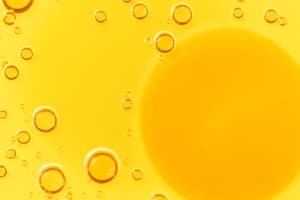Podcast
Questions and Answers
Which type of oral liquid dosage form contains nearly saturated solutions of 85% sugar in water?
Which type of oral liquid dosage form contains nearly saturated solutions of 85% sugar in water?
- Elixir
- Syrup (correct)
- Emulsion
- Suspension
What type of oral liquid contains one or more active ingredients dissolved in a vehicle with a high proportion of sucrose or a suitable polyhydric alcohol or alcohols?
What type of oral liquid contains one or more active ingredients dissolved in a vehicle with a high proportion of sucrose or a suitable polyhydric alcohol or alcohols?
- Emulsion
- Suspension
- Elixir (correct)
- Syrup
Which type of oral liquid dosage form contains suspended active ingredients in a suitable vehicle, where the suspended solids may slowly separate on keeping but are easily redispersed?
Which type of oral liquid dosage form contains suspended active ingredients in a suitable vehicle, where the suspended solids may slowly separate on keeping but are easily redispersed?
- Suspension (correct)
- Elixir
- Emulsion
- Syrup
What is defined as a dibasic or heterogeneous liquid preparation of immiscible liquids dispersed as minute globules in another liquid by adding an emulsifying agent?
What is defined as a dibasic or heterogeneous liquid preparation of immiscible liquids dispersed as minute globules in another liquid by adding an emulsifying agent?
What is the primary purpose of purifying and filtering the water used in liquid dosage forms?
What is the primary purpose of purifying and filtering the water used in liquid dosage forms?
Which type of oral liquid dosage form usually contains Ethanol (95 per cent) or a dilute Ethanol in its vehicle?
Which type of oral liquid dosage form usually contains Ethanol (95 per cent) or a dilute Ethanol in its vehicle?
What instrument is used to measure viscosity in a suspension?
What instrument is used to measure viscosity in a suspension?
How is particle size determined in a Coulter counter?
How is particle size determined in a Coulter counter?
What keeps particles suspended in a medium?
What keeps particles suspended in a medium?
Which law assumes dilute suspensions, spherical particles, and absence of interference in relation to sedimentation?
Which law assumes dilute suspensions, spherical particles, and absence of interference in relation to sedimentation?
What does the sedimentation volume (F) indicate?
What does the sedimentation volume (F) indicate?
Which method is used for estimating particle size with a micrometer?
Which method is used for estimating particle size with a micrometer?
What is the process that leads to larger droplet size over time in emulsions?
What is the process that leads to larger droplet size over time in emulsions?
What is the main factor that influences globule size distribution in emulsions?
What is the main factor that influences globule size distribution in emulsions?
What can cause irreversible damage to emulsions?
What can cause irreversible damage to emulsions?
What is the maximum dispersed phase concentration in an ideal emulsion?
What is the maximum dispersed phase concentration in an ideal emulsion?
What can lead to emulsion instability if it occurs for extended periods?
What can lead to emulsion instability if it occurs for extended periods?
What causes emulsions to change their physicochemical properties and become unstable?
What causes emulsions to change their physicochemical properties and become unstable?
What is the purpose of the light transmission test in syrup quality evaluation?
What is the purpose of the light transmission test in syrup quality evaluation?
Which parameter is crucial for patient adherence and product stability in pharmaceuticals?
Which parameter is crucial for patient adherence and product stability in pharmaceuticals?
What is the purpose of emulsifying agents in emulsions?
What is the purpose of emulsifying agents in emulsions?
Why is pH adjustment necessary in medicated syrups?
Why is pH adjustment necessary in medicated syrups?
What is the purpose of viscosity measurement in elixirs?
What is the purpose of viscosity measurement in elixirs?
What is the primary function of HPLC and UV spectroscopy in pharmaceuticals?
What is the primary function of HPLC and UV spectroscopy in pharmaceuticals?
What is the primary difference between microemulsions and nanoemulsions?
What is the primary difference between microemulsions and nanoemulsions?
How can o/w emulsion be differentiated from w/o emulsion using the dye solubility test?
How can o/w emulsion be differentiated from w/o emulsion using the dye solubility test?
What is the result of flocculation in an emulsion?
What is the result of flocculation in an emulsion?
What factors can help reduce creaming in an emulsion?
What factors can help reduce creaming in an emulsion?
Why is an optimum viscosity desirable for good emulsion stability?
Why is an optimum viscosity desirable for good emulsion stability?
What tests can be used to differentiate between o/w and w/o emulsions?
What tests can be used to differentiate between o/w and w/o emulsions?
Flashcards are hidden until you start studying
Study Notes
- Emulsions come in various sizes and types: 1. Microemulsions (< 1 nm, thermodynamically stable), 2. Nanoemulsions (10-1000 nm, kinetically stable), 3. Macroemulsions (0.2 to 50 mm, kinetically stable), and 4. Multiple/double emulsions (o/w/o or w/o/w, kinetically or thermodynamically stable).
- Nanoemulsions are kinetically stable but will eventually separate, while microemulsions are thermodynamically stable and will not separate even after a long time.
- Emulsions can be differentiated using tests such as conductivity, dye solubility, and dilution.
- Conductivity test: o/w emulsion conducts electricity as water is the external phase.
- Dye solubility test: o/w emulsion appears red when mixed with oil-soluble dyes under a microscope.
- Dilution test: o/w emulsion can be diluted with water, while w/o emulsion can be diluted with oil.
- Emulsion stability is essential and can be affected by issues such as creaming or sedimentation, cracking, and phase inversion.
- Flocculation is the aggregation of droplets without any change in primary droplet size. It is a result of insufficient repulsion between droplets.
- Creaming or sedimentation can be observed when external forces exceed thermal motion, leading to a concentration gradient and a layer of larger droplets forming at the surface or bottom of the emulsion.
- Factors affecting creaming include the size of the globules, the density difference between the phases, and the viscosity of the continuous phase.
- Decreasing globule size, decreasing density difference, and increasing the viscosity of the continuous phase can help reduce creaming.
- An optimum viscosity is desirable for good emulsion stability as it reduces both flocculation and creaming.
- Emulsion stability is important for maintaining the appearance, accurate dosage, and preventing the probability of globule coalescence.
Studying That Suits You
Use AI to generate personalized quizzes and flashcards to suit your learning preferences.




